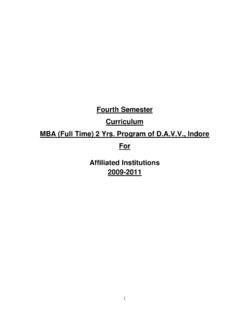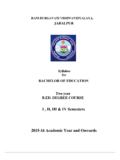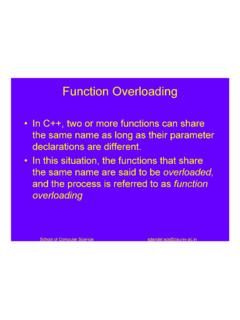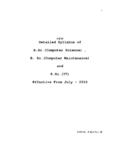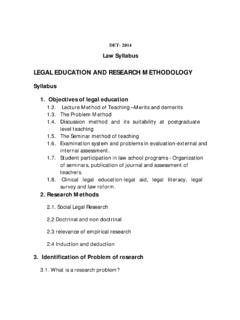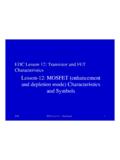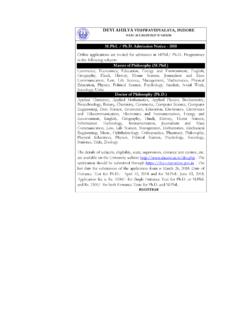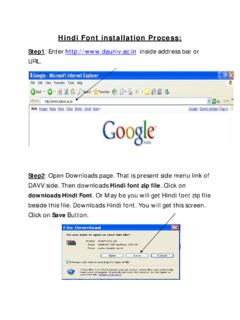Transcription of First Semester Curriculum MBA (Full Time) 2 Yrs. …
1 1 First Semester Curriculum MBA ( full time ) 2 yrs . Program of , Indore For Affiliated Institutions 2 DEVI AHILYA VISHWAVIDYALAYA, INDORE master OF business administration (MBA) Curriculum FOR full - time COURSES First YEAR First Semester SUBJECT CODE LIST OF SUBJECTS FT 101C Management Principles and Practices 1-2 FT 102C Mathematics and Statistics for Managers 3-4 FT 103C Accounting for Managers 5-6 FT 104C IT and E- business Fundamentals 7-8 FT 105C business Environment 9-10 FT 106C Organization Behavior and Processes 11-12 FT 107C business Communication 13-14 FT 108C business Legislation 15-16 COURSES AND SYLLABUS FOR SECOND, THIRD AND FOURTH Semester SHALL BE COMMUNICATED LATER.
2 3 FT-101C MANAGEMENT PRINCIPLES AND PRACTICES Course Objective The objective of this course is to help the students gain understanding of the functions and responsibilities of the manager, provide them tools and techniques to be used in the performance of the managerial job, and enable them to analyze and understand the environment of the organization. Examination The faculty member will award internal marks out of 20 (8 for Tests and 12 for class participation). The Semester examination carrying 80 marks will have two sections A and B. Section A worth 60 marks will have 6 theory questions out of which students will be required to attempt any four questions. Section B carrying 20 marks will contain one or more cases.
3 Cases prescribed below are only for classroom discussion and internal evaluation and not for end Semester examinations Course contents 1. Concept of Management Functions and Responsibilities of Managers, Fayol's Principles of Management, Management Thought - The Classical School, the Human Relations School, Systems Theory, Contingency Management, Developing Excellent Managers. Cross cultural issues in management. Case:Shui Fabrics. 2. Planning Nature and Purpose of Planning, The Planning Process, Principles of Planning, Types of Planning, Advantages and Limitations of Planning. Case:Planning for Diversified Activities in a Changing Environment 3. Concept and Nature of Objectives: Types of Objectives, Importance of Objectives, Setting Objectives, Management by Objectives (MBO), Benefits and Weaknesses of MBO.
4 Case:Detroit and Toyota 4. Strategies and Policies: Concept of Corporate Strategy, Formulation of Strategy, Types of Strategies. The Strategic Planning Process, The TOWS Matrix, The Portfolio Matrix, Three Generic Competitive, Strategies by Porter, Effective Implementation of Strategies, Types of Policies, Principles of Formulation of Policies, Decision Making Process, Individual Decision Making Models. Case: Coke verses Pepsi 5. Organizing Nature and Purpose of Organizing, Bases of Departmentation, Span of Management, Determinants of Span of Management, Line and Staff Relationship, Line-Staff Conflict, Bases of Delegation, Kinds of Delegation and Decentralization, Methods of Decentralization. Case:Bajaj Auto 4 6. Controlling: Concept and Process of Control, Control Techniques, Human Aspects of Control, Control as a Feedback System, Feed Forward Control, Preventive Control, Profit and Loss Control, Control Through Return on Investment, The Use of Computer for Controlling and Decision Making, The Challenges Created by IT as a Control Tool.
5 Case: Controlling Information At Frito-lay, INC. Text Readings 1. Stephen P. Robbins, David A. Decenzo, Sanghmitra Bhattacharya, 7 Madhushree Nanda Agarwal, Fundamentals of Management, Pearson Education, 2009 2. Kreitner, Management Theory and Applications, Cengage Learning,India, 2009 3. Robbins, Management, 9th edition Pearson Education, 2008, 4 Griffin, Management Principles and Applications, Cengage Learning,India First Edition 5 Harold Koontz, O'Donnell and Heinz Weihrich, Essentials of Management. New Delhi, Tata McGraw Hill, 2006 6 Stoner, Management, PHI Learning, 2008 7 Richard L. Daft, Principles Of Management, Cengage Learning,India, 2009 Suggested Readings 1 Anil Bhat & Arya Kumar Principles Proccesses and Practices 1st Edition 2008 Oxford Higher Education 2 Satyaraju & Parthsarthy,Management Text and Cases, PHI Learning, 2009 3 Chandan, Management Theory and Practice,1st edi,Reprint2007 Vikas Publishing House.
6 4 Kanishka Bedi, Management and Enterpreneurship, 1st Edition 2009 Oxford Higher Education 5 FT 102C MATHEMATICS AND STATISTICS FOR MANAGERS Course Objective The objectives of the course are to equip the students with the mathematical and statistical techniques and their application to business problems. The emphasis will be on the concepts and application rather than derivations. Examination The faculty member will award marks out of a maximum of 20 marks for the internal performance of the student (8 marks for internal test and 12 marks for cases / class participation). The Semester Examination will be worth 80 marks. It will have two Section, A and B. Section A will contain four questions from Part I- business Mathematics. Similarly, Section B will contain four questions from Part II- business Statistics.
7 A student will be required to attempt any five questions with a minimum of two questions from each section. The questions will contain theoretical as well numerical and/or cases/ practical problem(s). All questions will carry equal marks. Course Contents PART I business MATHEMATICS Mathematical Preliminaries- Numbers, Sequences and Series, Progressions (Arithmetic, Geometric and Harmonic), Set, Sub- sets and functions. (Students should be familiar with the concepts but there will be no questions from preliminaries in the examination). 1. Sets and Functions: Venn diagram and its applications, Operations on sets, Cartesian product of sets, applications. Functions - Algebraic functions (polynomial - linear, quadratic and rational), transcendental functions (exponential, log and trigonometric functions with identities).
8 Examples of business Applications. 2. Limits and Continuity of Functions: Introduction, Limit of a variable and a function, Implications of Limit of Functions, Continuity of a function of one variable. 3. Differentiation concepts: Derivatives of a function, derivatives of sum, difference, product and quotient, applications of differentiation in economic and managerial problems like marginal analysis, elasticity, Maxima and Minima- Concept and uses. 4. Integration Concepts: Elementary integration, Integration by parts, Simple definite integrals, economic application, consumer surplus and producer surplus. 5. Discounting, Compounding, and Annuity. 6. Vectors, Matrices and Determinants with business application: Vectors, Operations on Vectors, Matrices Types of matrices, operations on matrices, adjoint of matrix, inverse of a matrix, elementary row operations.
9 Solution of simultaneous linear equations using matrices/ determinants, input/output analysis. PART II business STATISTICS Statistical Preliminaries- measures of Central Tendency- Mean, Median, Mode, Measures of dispersion- mean deviation and standard deviation. (Students should be familiar with the concepts but there will be no questions from preliminaries in the examination). 6 1. Introduction to Statistics: Meaning and Definition of Statistics, Scope and Limitations of Statistics, Role of Statistics in Management Decisions, 2. Probability Theory and Probability Distributions: Concepts, additive, multiplicative, conditional probability rules, Baye s Theorem, Binomial, Poisson and Normal distributions- their characteristics and applications 3.
10 Correlation & Regression: Correlation (Karl Pearson s and Spearman s Coefficients), Methods of computing simple correlation and regression Line of Regression, Curve Fitting- Least Square Method) 4. time Series: time Series and its Components, Analysis, Models of time Series, Methods of Studying Components of time Series: Measurement of trend (moving average and least squares method), Measurement of seasonal variations (moving average method) Measurement of cyclic variations (residual method). 5. Statistical Decision Theory: Decision making process, Decisions under Uncertainty and Decisions under Risk. Text Reading 1 Sharma, Mathematics for Management and Computer Applications , New Delhi, Galgotia Publication, 2 R. K. Ghosh and S.
